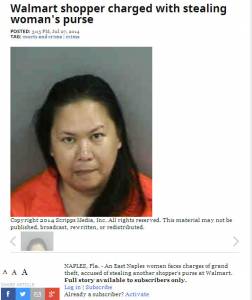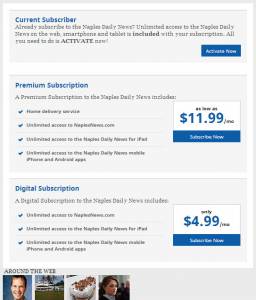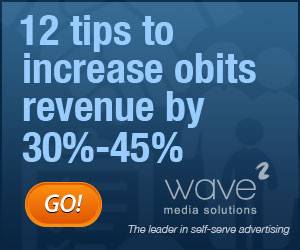Is Scripps' content-based meter a better paywall model?
An in-depth look at valuing stories based on content and time
Company: E. W. Scripps
Key executives: Adam Symson, Chief Digital Officer, E.W. Scripps; Bruce McLean, Sr. Director of Online Operations, E.W. Scripps
Initiatives: Time-based paywall meters
Summary: E. W. Scripps' time-based paywall was fully implemented across its thirteen newspaper sites by the end of 2013. The model meters content based on the category of content rather than the standard model, based on the number of articles consumed by a visitor. Scripps executives say time-based meters offer significant advantages over quantity- based meters for most content categories: The ability to compete with broadcast sites, elimination of “porousness" from visitors avoiding the paywall by clearing their cookies or switching devices, and the ability to learn more about which content visitors will pay to see. So far, the approach is hitting its financial targets. Here’s how the system works.
Challenge: In 2012, like many media companies, E.W. Scripps decided to develop a paywall for its newspaper properties - one that was ultimately completed in the third and fourth quarters of 2013.
However, with more than 20 television sites in addition to thirteen major newspapers, Scripps executives were sensitized to the competitive advantages of broadcast news online, where the models converge. Television, with its strength in urgent, breaking news, weather and video, is increasingly competitive online, where it can add text, depth and analysis. At the same time, newspapers were switching to immediate posting of breaking news, especially important on mobile devices.
And just at a point where real competition between television and newspapers for the digital news consumer ensued, newspapers began putting up paywalls.
"My concern with the “nth article” meter is that it creates the friction necessary (to sell subscriptions) but short circuits the ability to build a brand among the growing utility-based news consumer on mobile platforms," said Adam Symson, Senior Vice President and Chief Digital Officer, E. W. Scripps Company.
Another concern was the porous nature of paywalls.
“They have lots of leakage," Symson adds, such as when people clear their cookies, switch devices or simply Google a headline from a site that allows search traffic inside.
Could a time-based meter according the the type of content, provide a better solution than an nth article-based meter?
Strategy: The E.W. Scripps’ team decided to test the time-based meter model, in which editors assigned paywall status and/or time outside the paywall to each piece of content.
Breaking news can stay free for a couple of hours while print competes with broadcast on the story. Then as the news depth increases beyond what broadcast sites supply – it falls behind the paywall.
See the small "Full story available to subscribers only" area below this local story, "Walmart shopper charged with stealing purse":

“Rather than a page meter which allows the user to have access to any article until they hit the wall, we wanted to place value on the content itself,” said Bruce McLean, Senior Director of Online Operations, who helped develop the new system.
The pricing strategy – served to readers via a pop-up window - varies by the market with some specials like the example below from the Naples market: Newspaper subscriptions are $11.99 a month, and $4.99 special for digital only and/or the bundle, including all devices.

If it's free on the laptop, it's free on the phone. If it is paid, it is paid everywhere.
Driving the metering policy for online news is competition from other sites.
“The newspaper has an advantage (over broadcast sites) because they have a depth of coverage and columnists – all these areas that nobody else has,” said McLean.
“We feel the value of the newspaper content lies in this area,”
Scripps is in a unique position to understand the metrics, as most of its online media properties are television sites, including the massive Cincinnati station, which charges for exclusive local content (see case study here).
New categories, same content
So how does this theory work in practice? To assign a time-based paywall to each piece of content, the digital team breaks down newspaper content into a number of distinct categories.
Like other paywall models, classifieds, wire service reports, photo galleries, community-posted blogs and ad-generating video content remain unwalled.
Obituaries still remain free, but one market is being tested using a traditional story metered model.
advertisement
McLean explains that there are two groups of obituary readers – occasional and habitual – and that the service to occasional readers looking for obituaries and service information about a friend or relative is unique and fundamental.
A metered model worked best to allow occasional readers who need the service to pass through unaccosted, but habitual readers who read obits daily, to pay.
However beyond these groups, content is divided in to three categories: 1. Free, perishable content, 2. Timed content, and 3. Exclusive paid content.
Taken one by one:
1. Free, perishable content stays free. This includes “utility” news that people need to know, but which does not rise to the level in which they would, say, follow-up on the story.
This category includes mainstays of broadcast beats, where newspaper sites are making inroads: Traffic jams, freeway accidents and weather reports - typically the purvey of television sites as well.
2. Timed content stays free for two hours. With a time-based meter, news that is relatively perishable and similar to those published in other places can stay live for two hours, then drop behind the paywall as depth is added.
So, for example, local headline news covered on television can stay free – for a while.
“As the day progresses and the (newspaper) goes deeper and deeper, developing depth and perspective, those stories are marked as paid.”
Sports coverage plays by same rules: Game coverage is in the timed category until shortly after the game and eventually falls behind the meter.
3. Exclusive content starts behind the paywall. Anything exclusive and especially highly local enterprise reporting, such as Sunday enterprise reports, falls into this category.
But the category includes virtually any exclusive content, including columnists, in depth features, and reviews - “basically, anything we feel can't be found anywhere else,” McLean said.
A key area for conversions is local business news, which has a smaller readership but higher conversions rates, consistently across markets.
But there are also some grey areas that remain determined by the editors and based on the market.
Niche content such as food, entertainment and travel, for example, are determined on a case-by-case basis. A recipe may be free but the food columnist may be behind the paywall. Here's an example of a local article on wines - not hard news, but still requiring payment or a log-in:

“The market plays a role. If there is another media or publication, for example, that provides the same niche coverage free,” McLean said.
Basically, editors are trained to work off of a simple criteria, which they already know:
“Was the news reported elsewhere, or in-depth and unique to the newspaper's site?”
From there feedback on conversions from each story type become important.
“We play around with it. Overall the goal is the same, when you think in terms of what content has high value in your local market, it is a quantitative measurement (editors) can understand."
Software required
In this case, E.W. Scripps worked with two main software companies, their CRM provider, DTI, and Synchronix which allows the subscription system to communicate with the CRM. (Note: Press+ now also offers a time-based meter).
Editors assigned the time-based length on the meter to each story by means of a check box on the admin side.
After training on the value of different kinds of news, McLean said that editors had no trouble understanding how to use the meter for highest benefit.
Results and lessons learned
• The company hit its 2013 goals for digital-only subscription sales and ais on track to hit aggressive 2014 goals.
• The meter is especially effective in activating print subscribers; online sales that bundle in print has an uptake approaching 50%.
• Training editors was one of the easiest components of the plan.
“They understand a story based on an event a lot of people have already been to is not the same value as a story that uncovers some kind of wrong-doing. They intrinsically understand value, so they can put the stories in to different categories."
• An advantage is the ability to experiment and learn consumer news preferences from the content.
• Another plus is elimination of porousness. “There is really no way of getting around it. If you clear your cookies or go to another device” – or simply Google the exact headline in the case of many sites that allow search traffic through the paywall.
• The model is closer to retails' 'time-based yield management,' in which inventory is priced based on longevity, Symson says.
“It’s just a different sort of rubric...Instead of saying 'I'm indifferent to the story", (the meter) is not about the person, it's about the story… In a way, he says, it is a “retail strategy rather than a publisher strategy."
Many thanks to Adam Symson, Chief Digital Officer; and Bruce McLean, VP of Operations, E.W. Scripps for walking us through this model.

Adam Symson, Chief Digital Officer, E.W. Scripps

Bruce McLean, Sr. Director of Online Operations, E.W. Scripps
advertisement







